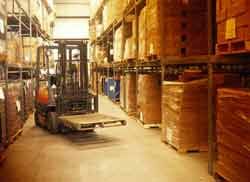Optimizing Warehouse Management
Although software and the overall warehouse management solution (WMS) are crucial tools, common problems include failure to put in place an efficient warehouse layout best suited to the products being handled, lack of knowledge of the inventory on hand, and inadequate preparation and training of personnel.

Warehouse solutions include both the software and hardware used to ensure accuracy of inventory and organization of product services, such as shipping, receiving, inventory management, product or service layout, staff, bins, and purchasing. Having the right software in place is an integral component to a pharmaceutical organization’s supply chain and is crucial to the success of overall business processes. Appropriate software simplifies inventory processing through automation, thus ensuring tight control and lot tracking at all levels of warehouse management, and meets pharmaceutical industry-specific regulations and institutional requirements.
Although software and the overall warehouse management solution (WMS) are crucial tools, common mistakes can make it challenging to maintain a successful warehouse operation even when these tools are being used. Common problems include failure to put in place an efficient warehouse layout best suited to the products being handled, lack of knowledge of the inventory on hand, and inadequate preparation and training of personnel.
Warehouse layout
It may sound like a simple concept, but having a logical warehouse layout is paramount to the success of any warehouse solution. Think of a warehouse like an architectural blueprint--an easy-to-navigate system where each section is clearly defined. Most warehouses store product materials in bins that are often scattered throughout the warehouse floor, which makes it challenging to find a product’s location and causes delays and errors in product shipment. To avoid this, companies can establish a naming convention for bins so warehouse staff can find things quickly and easily, thus creating a logical sequence to bring people to where they need to be. Name the bins and layout the warehouse in such a way that when someone looks at a bin tag, they will know how to find the bin.
How well you and your staff know your products and inventory on hand will also help determine the warehouse layout and ultimate success of warehouse software. Place higher moving products near picking lanes that are close to shipping areas, place bulk areas in a location to facilitate bin replenishment, and determine logical areas for items that require cage, cooler, and vault storage. Be aware of how products are moving so that you can periodically rearrange their location in the warehouse as needed. A good WMS will show how a system is performing and how products are coming in and going out.
Within a pharmaceutical manufacturing facility, be sure to segregate products by keeping controlled substances in a locked area. Apply the same logic and flexibility to expensive, dangerous, or hazardous items that need to be kept in a specific place (i.e., safe zone). It is crucial for staff to keep records of date tracking, as most products have expiration dates, which could potentially result in shipping of outdated or near-date product.
Assigning and training personnel
One of the most important components of developing a logical warehouse is the staff. The number of warehouse personnel will play a crucial role in operational effectiveness. With a large warehouse staff, consider organizing employees into smaller or specialized groups and assign specific employees to specific areas. Each situation will be unique based on the products a company is moving and the size of the staff.
When investing in warehouse management software, it is important to test whether the software will operate with other existing technologies, such as RF scanners, and with automation systems, such as conveyors and carousels. Once a warehouse solution has been selected, tested, and implemented, employees should be trained on every component of the system to best maximize the warehouse solution investment and ensure that warehouse inventory is being moved and tracked in the most efficient manner. Whether it is bar code and radio-frequency (RF) data collection, returns, order management, or other software that is leveraged for warehouse management, personnel need to be trained and become comfortable using this technology.
The key to successfully implementing a warehouse solution and ensuring streamlined operations, automated processes, top efficiency, and reduced costs is to make sure that the most important assets—products and staff—are well prepared and organized in all areas of warehouse operations.

Joe Scioscia is vice president of sales at VAI.

Drug Solutions Podcast: A Closer Look at mRNA in Oncology and Vaccines
April 30th 2024In this episode fo the Drug Solutions Podcast, etherna’s vice-president of Technology and Innovation, Stefaan De Koker, discusses the merits and challenges of using mRNA as the foundation for therapeutics in oncology as well as for vaccines.
Pharmaceutical Tariffs Are Imminent: How Industry is Bracing for Impact
April 16th 2025On April 14, 2025, the Trump Administration launched a national security-driven investigation into pharmaceuticals, a move that will likely result in tariffs being placed on pharmaceutical drugs, ingredients, and other components that are imported from outside of the United States.